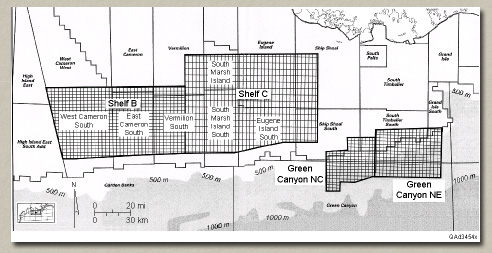

|
|
| Imaging Deep Gas Targets with Multicomponent Seismic Data |
Bob A. Hardage, principal investigator; Milo M. Backus, Michael V. DeAngelo, Sergey B. Fomel, Khaled Fouad, Robert G. Graebner, Paul E. Murray, Randy L. Remington, and Paul C. Sava Operators across the Gulf of Mexico (GOM) are targeting deeper and deeper drilling objectives. For deep targets to be evaluated, seismic data are required that have longer and longer source-receiver offsets. Most shallow-water operators in the GOM consider 30,000 ft (9 km) to be the greatest target depth to be drilled for the next several years. For geology at depths of 9 km to be imaged, seismic reflection data must be acquired with offsets of 9 km or more. This long-offset requirement is difficult to achieve using towed-cable seismic technology in areas that are congested by production facilities, which is the situation for many shallow-water blocks across the northern GOM shelf. Ocean-bottom-cable (OBC) and ocean-bottom-sensor (OBS) technologies are logical options for long-offset data acquisition in congested production areas because ocean-floor sensors, once deployed, are immobile and can be positioned close to platforms, well heads, and other obstructions that interfere with towed-cable operations. An additional appeal of OBC seismic technology is that four-component (4-C) data can be acquired, allowing targeted reservoir intervals to be imaged with P-SV wavefields, as well as P-P wavefields. Once 4-C seafloor receivers are deployed, source boats can maneuver along a receiver line to generate P-P and P-SV data from long-offset distances. This research is designed to investigate the value of long-offset multicomponent seismic data for studying deep-gas geology across the northern shelf of the GOM. The term long offset means that 4-C OBC data are processed using uniformly sampled source-receiver offsets ranging from 0 to 10 km. The study area is a large, 3,200-mi2 (8,200-km2) section of the Louisiana shelf noted for prolific gas production. Data consist of parallel north-south and parallel east-west 2-D4C profiles spaced at intervals of 2 mi. P-P and P-SV images produced from these long-offset reflection data are interpreted to determine the relative depth-imaging capabilities of each seismic mode. Analysis of these long-offset data shows that the P-P mode contains reflection signals from depths of 60,000 ft (18 km), which is deeper than any reported seismic reflection effort in the GOM basin. Equally important, the critical P-SV mode has a reflection signal from depths of 42,000 ft (13 km). |
 |
These four 4-C OBC surveys, Shelf B, Shelf C, Green Canyon NC, and Green Canyon NE, were acquired with source-receiver offsets of 9 and 10 km. This study will concentrate on data from the Shelf B and Shelf C areas. |
|
For
more information, please contact Bob
Hardage, principal investigator. |